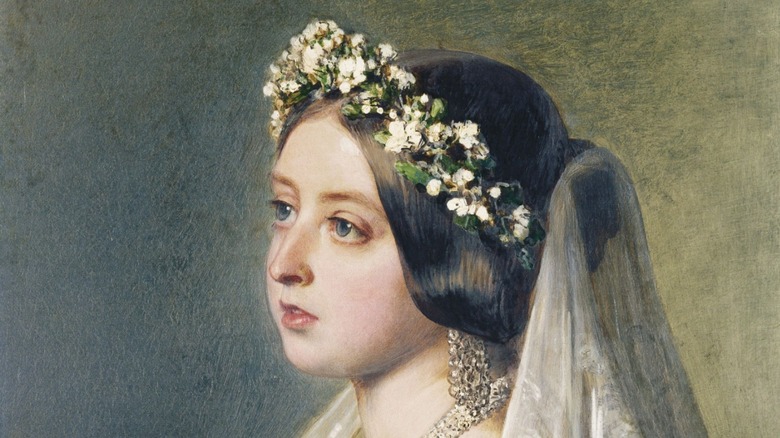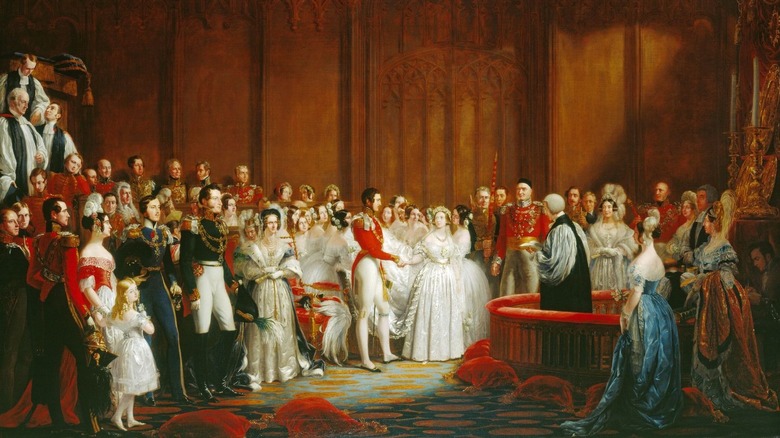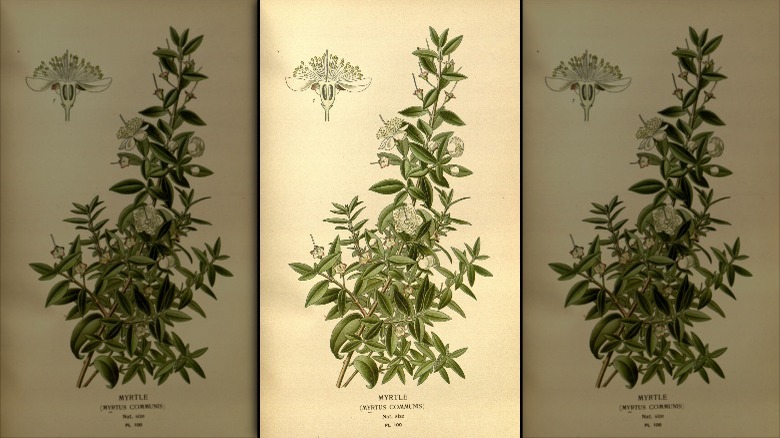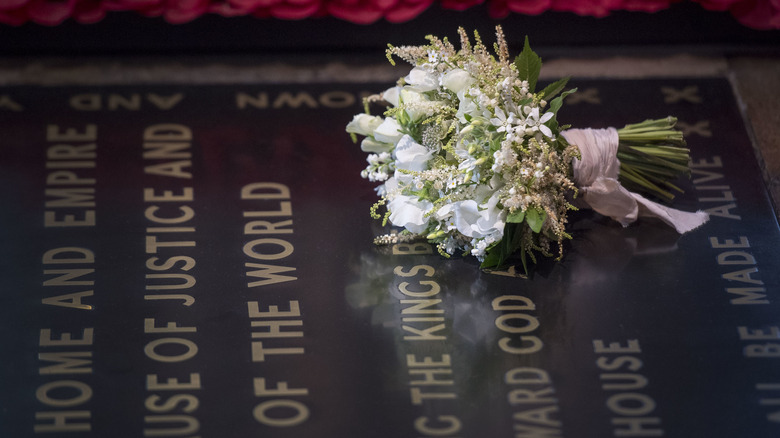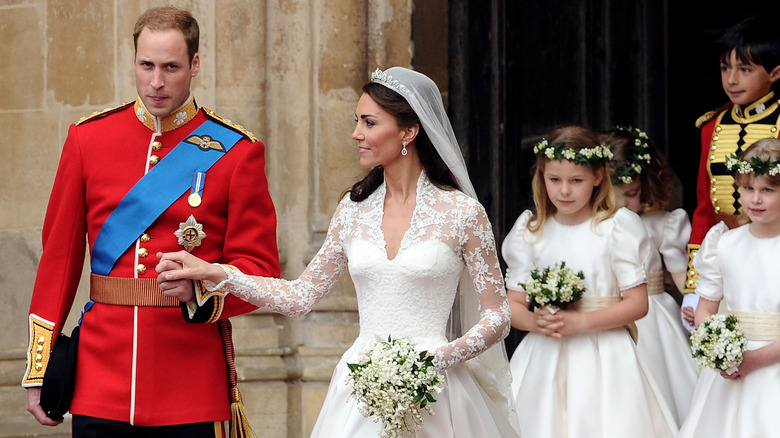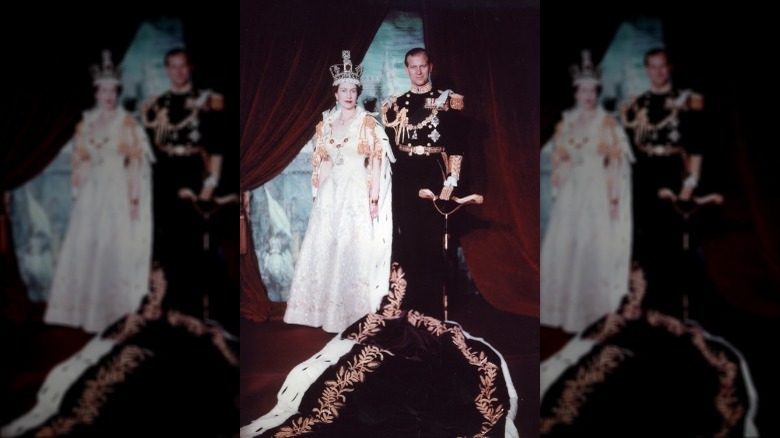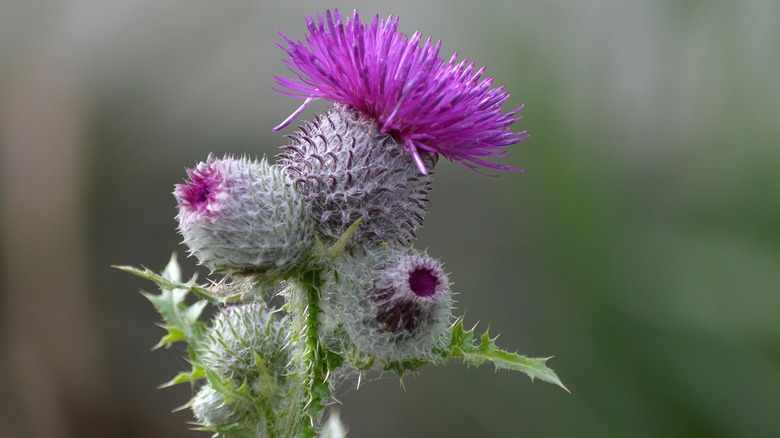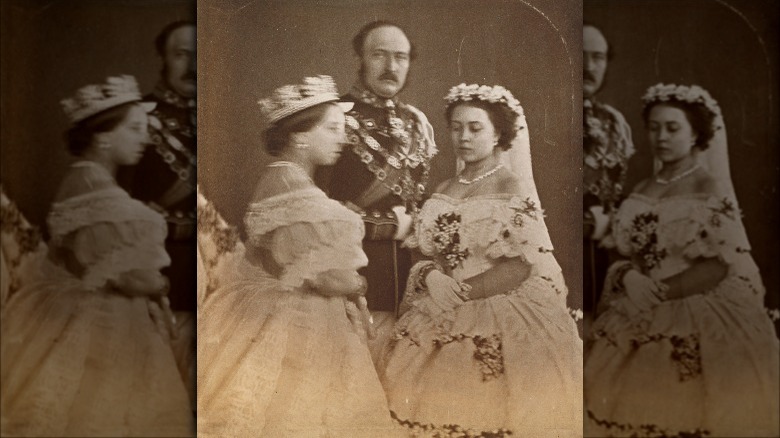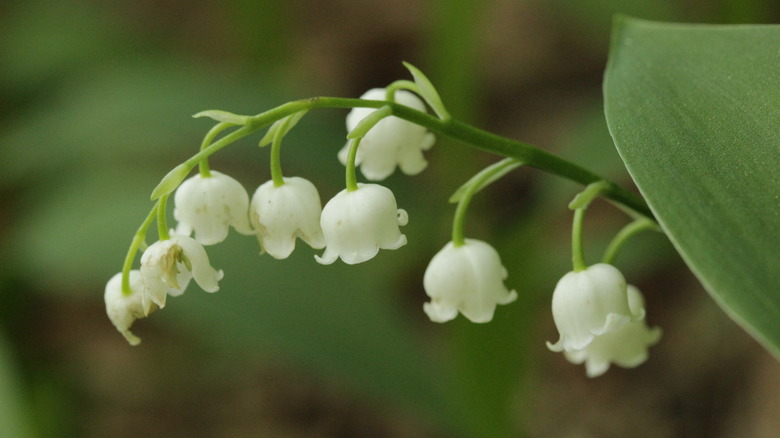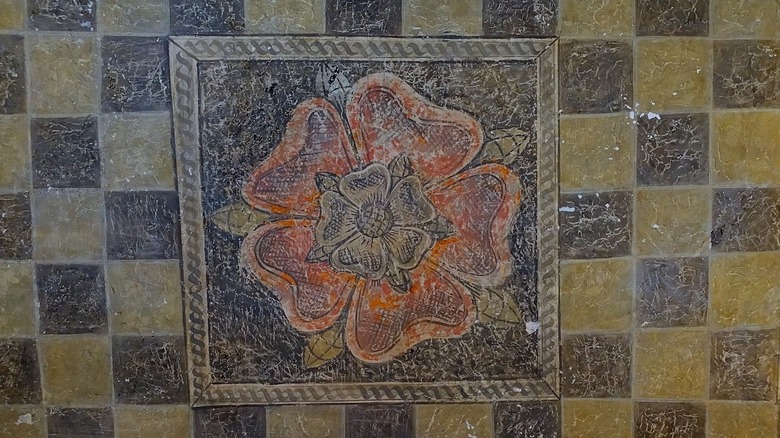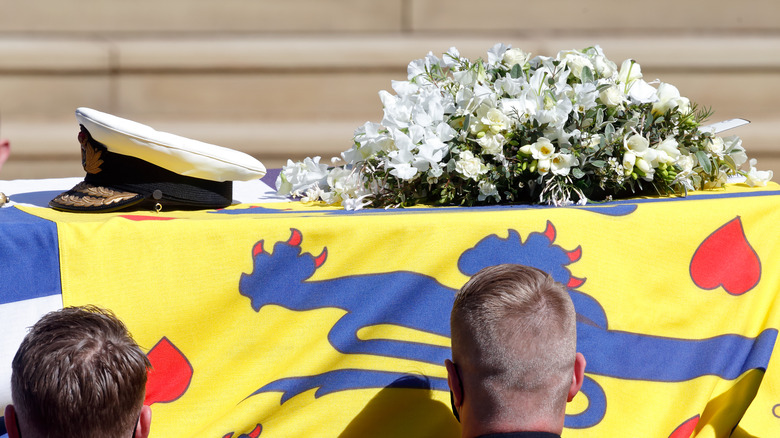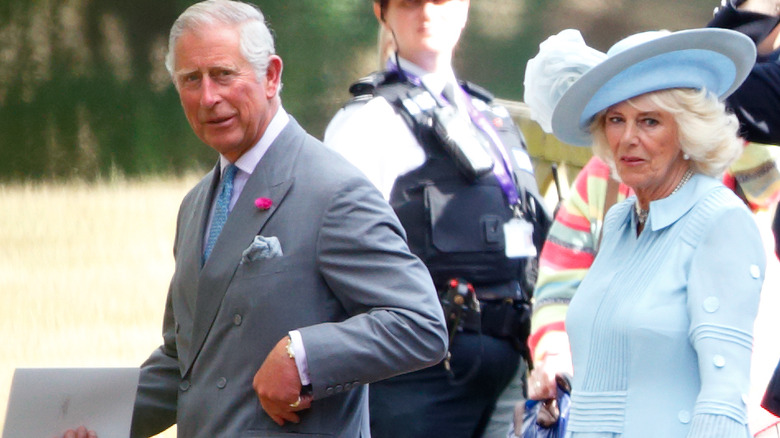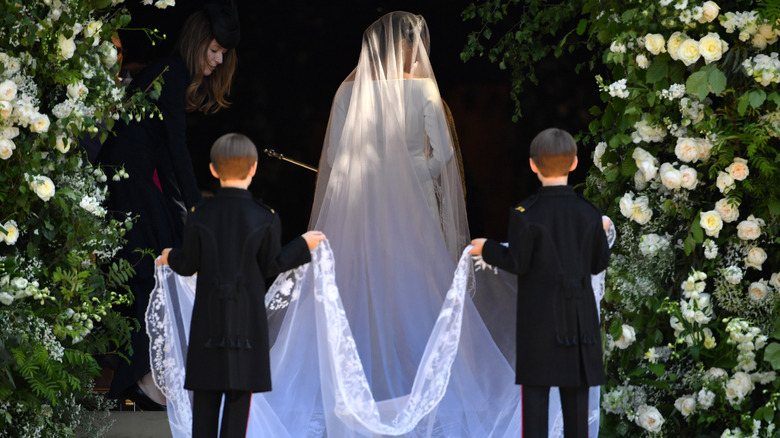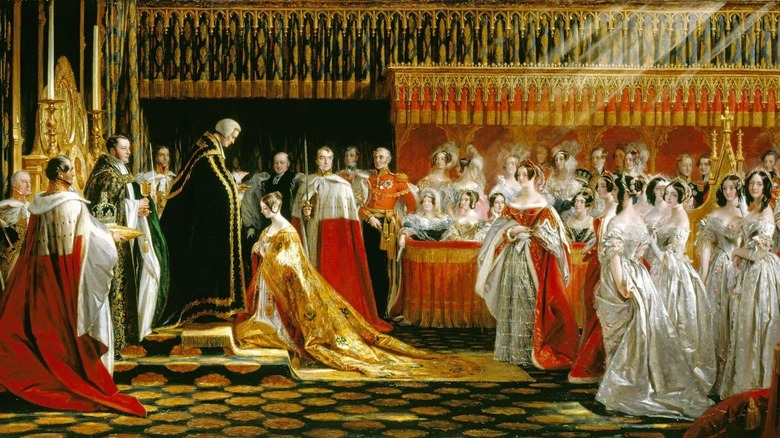British Royal Flower Traditions Explained
It's safe to say that there is a lot of pomp and circumstance involved in being a British royal. Some members of the family may escape some of the more ceremonial duties, but the monarch and their immediate family are certainly expected to take part in quite a few occasions. And whether it's a memorial, a wedding, a coronation, or anything in between, there are sure to be plenty of flowers.
Now, at first, flowers might seem like little more than a frivolous bit of set dressing, some pretty decoration to really amp up the occasion. Yet, as with so many of the traditions practiced in British royal circles, it goes quite a bit deeper than appearances. Even apparently innocuous things like the type of flowers, their arrangements, their color, their scent, and more can send a pretty strong message.
Much of the symbolism and import of floral arrangements here is tied up in floriography, or the "language of flowers." The idea of communicating a message via blooms has been around in one form or another for centuries. Yet, in Britain and especially when it comes to the country's royals, their history with floral symbolism is a bit more recent. According to the Royal Horticultural Society, floriography really started flourishing there under the reign of Queen Victoria, who happens to be personally linked to quite a few flower traditions practiced by her descendants today.
Queen Victoria started many British royal flower traditions
In an era where "floriography," or the language of flowers, flourished, Queen Victoria seems to have gone all-in on the trend from nearly the very beginning of her reign. Quite a few royal floral traditions, including many centering on weddings, can be traced back to her.
Now, as English Heritage notes, that's no reason to dismiss the fact that flowers have been central to symbolic thought for centuries. But it's pretty fair to say that the intense focus on flowers as symbols within the English-speaking world arose during Victoria's reign. Authors in both England and France seem to have made a cottage industry of books purporting to explain the quasi-mysterious world of communicating via blooms.
That said, while Queen Victoria was establishing some pretty visible floral symbolism for her royal descendants — she seemed to be especially fond of orange blossoms, wearing them on her wedding day (via Royal Collection Trust) — it's not clear that regular folks ever went all-in on messaging through bouquets. Rather, it appears to have been a fun thought experiment or distraction. But royals, with their large budgets and need to create visually stunning events, have proven to be a bit more serious about flower traditions through the years.
Myrtle is traditionally part of every royal wedding bouquet
Royal brides both historic and modern have typically carried a sprig of myrtle in their bouquets. In particular, that bunch of myrtle is supposed to come from Osborne, reports English Heritage. That's the vacation home of Queen Victoria, situated on the Isle of Wight off the southern coast of England. Records show that Victoria started the tradition at the 1858 marriage of her daughter, also named Victoria. The event was apparently pretty significant for the elder Victoria, who later wrote in her diary that "I felt almost as if it were I that was being married over again."
Indeed, Victoria keeps talking about myrtle in her diaries, noting that its flowers were part of Princess Beatrice's 1885 wedding and the 1874 pre-nuptial bouquet sent to the Russian Grand Duchess Marie, who was set to marry her son, Alfred. It all apparently stems from a small bouquet containing the flowers, which was given to Victoria by Prince Albert's grandmother during a royal trip to Germany.
But why myrtle? It clearly had a personal significance for Victoria and her immediate family, but myrtle had already gained a centuries-old reputation for representing romance, innocence, and fertility — pretty spot on symbolism for a wedding. It was especially popular in 19th century Germany and, considering that Victoria and quite a few of her descendants are descended from the German Hanovers (via The Royal Family), it makes cultural sense, too.
Royal brides leave their flowers at the Tomb of the Unknown Warrior
In a tradition started by Lady Elizabeth Bowes-Lyon, the mother of Queen Elizabeth II, royal brides traditionally leave their bouquets at the Tomb of the Unknown Warrior in Westminster Abbey, according to the BBC. Elizabeth left them there at the beginning of her 1923 wedding, held in the abbey. Her brother, Fergus, was killed in World War I in 1915, leading to Elizabeth's pre-ceremony gesture in his honor. Today, however, the bouquets generally stand in the bride's hands throughout the ceremony and are then deposited on the tomb the next day.
The tomb itself houses an unidentified British soldier recovered from WWI France. As Town & Country notes, the man was buried there in a public ceremony wherein King George V laid a wreath of red roses and bay leaves on the black marble tomb. Bay leaves represent glory, while red roses can mean love or, if they're an especially dark hue, mourning (via The Old Farmer's Almanac).
Queen Elizabeth II has carried other floral traditions around the tomb, even when there isn't a royal wedding taking place. According to The Royal Family, the centenary of the Unknown Warrior's burial was marked in part by another bouquet laid on the tomb. This time, it was a replica of Elizabeth II's own wedding arrangement, containing myrtle and white orchids.
Most royal wedding bouquets are traditionally all white and all British
The majority of royal brides in modern memory have carried all-white wedding bouquets, in keeping with the white wedding theme. There's also a practical purpose, since the flowers in question should be pretty eye-catching — this is a large public ceremony, after all — but not so attention-getting that people forget about the wedding dress. As florist Jane Packer said, "Protocol dictates that for an occasion such as this, the bouquet will be all-white" (via The Telegraph). The flowers, which have included blooms as luxuriant as orchids and as homegrown as Queen Victoria's myrtle, are therefore generally all white with only the rare hint of color.
Many ceremonies have also featured flowers that have only been grown in Britain. That was certainly the case at the wedding of Prince William and Kate Middleton, as The Guardian reports. Quite a few observers were reportedly "delighted" to see the patriotic choice of flowers, all grown by British businesses or else selected from British gardens, like the ever-present myrtle sourced from Osborne.
Elizabeth II's coronation bouquet and dress held important flower symbolism
Flowers aren't just a feature of royal weddings. In fact, a look at some of the other big events on the royal calendar shows that flowers and their attendant meanings are seemingly everywhere. Take one of the biggest days in a monarch's life — the day on which they are crowned.
On her coronation day in 1953, Elizabeth II carried a bouquet of all-white blooms, not unlike the royal brides before and after her. According to Royal Central, the various flowers included referenced the different regions of Britain. Specifically, orchids and lily of the valley represented England, carnation for Northern Ireland, different orchids grown in Wales, and a stephanotis for Scotland. The orchids and lily of the valley were also a callback to her own bridal bouquet from 1947, which included the two types of flowers.
Flowers weren't just in the queen's hands at the coronation — they were also on her dress. Per the National Gallery of Australia, Elizabeth's dress was embroidered with flowers and other plants representing the commonwealth. Fashion designer Norman Hartnell selected the maple leaf for Canada, a lotus flower to represent India, and the protea flower for South Africa, among others.
The Scottish thistle has been a royal symbol for centuries
Upon first glance, the thistle may not seem like an especially promising royal flower. The lush spectacle of orchids, of roses, of a trail of lily of the valley as it spills elegantly out of a bouquet seems more familiar. But the thistle comes off as rather defensive, with its prickles and spiky purple flower.
First used in a royal context when James III of Scotland issued coins bearing this flower in 1470, thistles have long been considered a symbol of Scotland, as Visit Scotland reports. James II of England also drew upon the rather strong, even fearsome symbolism of this thorny flower when he established the Most Ancient and Most Noble Order of the Thistle — more simply called the Order of the Thistle if you're into the whole brevity thing — in 1687.
Some members of the royal family are still part of the Order of the Thistle, which sports regalia that includes even more floral symbolism. Harper's Bazaar notes that, besides the luxuriant green velvet cape and feathered cap, members of the order also sport an enamelled chain featuring yet more thistles and rue. A Shakespeare Garden notes that, at least in British contexts, rue is often linked to regret for its bitter taste, as well as repentance and grief.
Orange blossoms are traditional for many royal brides
Read about any British royal wedding, and you're bound to see something about orange blossoms in many of them. While orange blossoms have long had plenty of symbolism all of their own, their British association appears to have originated with Queen Victoria herself.
On her 1840 wedding day, Queen Victoria wore a crown of her favorite orange flowers, which The Royal Family notes is a symbol for chastity. The blossoms became a popular royal tradition for subsequent weddings. Quite a few of her daughters and other descendants also featured this fragrant bloom in their weddings, typically worn as part of their wedding attire. Elizabeth Bowes-Lyon, the wife of future King George VI and future Queen Mother to Elizabeth II, even went so far as to wear a wreath incorporating orange blossoms.
Prince Albert even took it up as a theme for a series of jewelry pieces he would give to Victoria through the years. According to the Royal Collection Trust, the first piece he had made for her was a brooch that was actually sent prior to their marriage, when they were still an engaged couple in 1839. The blossoms were made out of porcelain. And, since these were a series of gifts to the queen, after all, the leaves of the set were made out of gold. A later headband added to the set even featured enamel oranges to represent Albert and Victoria's children.
Lily of the valley is a royal favorite
The particular whims and preferences of a sitting monarch are often enough to get quite a few traditions kick started, not least of which are some highly symbolic floral customs. Lily of the valley is reportedly a favorite of Queen Elizabeth II or, at least according to the Royal Family Twitter, it's held "special associations" ever since it was incorporated into her coronation bouquet.
The blooms have since featured in quite a few royal bouquets, per Express, including the wedding day blooms of Kate Middleton and Meghan Markle. According to Town & Country, it's said to represent good luck in love, while it's even the national flower of Finland. That said, it's also potentially poisonous if someone tries to eat the flowers. Possible side effects from ingesting lily of the valley can include stomach pain, fatigue, and dangerously low heart rates. Luckily, no royals have been seen trying to sneak a taste on their big day, which would be an odd occurrence indeed, anyway.
The Tudor rose royal symbol harkens back to war
Though many of us may now interpret the rose as a lush, romantic symbol of love, its meaning within British history is quite a bit more fraught. In fact, the lovely rose symbol that now represents all of England is linked to a brutal series of civil wars that gave rise to the Tudor dynasty.
As the BBC's HistoryExtra reports, a close look at the modern day "English rose" symbol shows a flower that sports both white and red petals. That's no accident. Before the conclusion of the 15th century Wars of the Roses, a separate white and red rose represented the two warring factions. The white was taken up by the House of York, while the red represented the House of Lancaster.
When Henry VII, the Lancastrian winner of the wars, was crowned king and then married Elizabeth of York in 1486, he cannily combined the two in order to make the red and white "Tudor rose." Over time, the combined symbol became a popular image of English patriotism, even becoming known as the "flower of England."
Flowers also have significance at royal funerals
Flowers feature in plenty of life's rituals, from beginning to end. And British royals, like so many other people worldwide, often use flowers to represent their emotion and grief in funerals. Take the funeral of Prince Philip, the duke of Edinburgh and spouse of Queen Elizabeth II. According to Royal Central, amongst the abundant symbolism of his funeral ceremony, there were also flowers that carried some pretty important significance both for the occasion and for Philip's widow.
The wreath of flowers on top of Prince Philip's coffin, all chosen by Queen Elizabeth, were assembled with both personal meaning and wider tradition in mind. Per the Independent, they included rosemary for remembrance, lavender for devotion, acanthus to represent Philip's birthplace of Greece, and white roses for June, the prince's birth month. Royal Central also reports that the wreath contained jasmine to represent strength and sweet peas, traditionally a bittersweet symbol of farewell.
Prince Charles carries on his own flower tradition at royal christenings
Prince Charles has been spotted with a consistent flower tradition seemingly of his own making, though not without some personal significance and visual impact. According to Yahoo Entertainment, he's often spotted wearing a bright pink dianthus in his buttonhole to nearly all of his grandchildren's christenings. Prince George's christening didn't see Charles sporting the flower — specifically, a variety known as the Dianthus Devon Wizard — perhaps because George was baptized into the Church of England in October, when the flower wouldn't have been growing.
Per Hello!, it's thought that the flower represents love, specifically of the enduring sort that a grandfather might feel for his grandchildren. It also connects to Charles' long-time championing of gardening and environmental causes. After all, the flower grows in the garden of his residence in the British countryside, Highgrove House. For a prince who's been a vocal advocate of environmentalism, it makes sense that he might select a flower that's more or less outside his front door instead of one with a larger carbon footprint in its history.
Royal wedding dresses can also contain flower symbolism
While royal weddings and other events can sometimes seem as if they're packed full of real flowers, the floral traditions of the British monarchy go even farther than the genuine article. A closer look at some of the details of what's often seen as the stylistic center of a wedding, the dress, shows that even these one-time gowns take part in British royal flower traditions.
Take Kate Middleton's dress. When the duchess of Cambridge was married to Prince William in 2011, it was in a long-sleeved lace gown that caught the eye of practically all the attendees and viewers of the ceremonies. Good Housekeeping reports that it contained significant flower designs, too, if you knew where to look. Middleton's dress included a rose for England, thistles for Scotland, daffodils to represent Wales, and shamrocks for Northern Ireland. The bloom designs were cut out individually and then painstakingly sewn by hand onto a silk tulle base.
Similarly, Meghan Markle's monumental 16-foot veil from her 2018 wedding to Prince Harry had enough room to display a flower from every country in the Commonwealth, according to Harper's Bazaar. There was still enough space for a few special additions, including a California poppy to represent Markle's birthplace, while ears of wheat near the front were placed as symbols of love and generosity.
Royal coronation oil contains flower essences linked to history
According to Westminster Abbey, the most sacred part of a monarch coronation ceremony is the anointing of the sovereign. The exact nature of the oil used in royal coronations is secret, but it's known to contain oils derived from flowers, including orange flower, jasmine, and rose. The particular blend used for Elizabeth II's 1953 ceremony was so important that it's still secret, and the actual anointing was not shown on television. It's the moment where a ruler is said to be linked to not only her earthly kingdom but to a divine Christian one as well.
The flowers represented by the essences may represent purity, love, honor, and other virtues hopefully associated with a sovereign — or they may also represent the richness and splendor of a British coronation that uses traditions over 1,000 years old. According to Hypothesis, the oil used in 1953 was based on recipes for a blend made in the 17th century to anoint Charles I.
